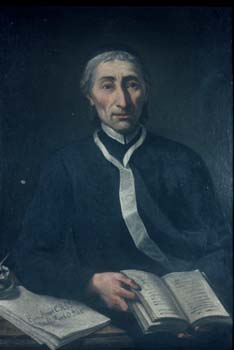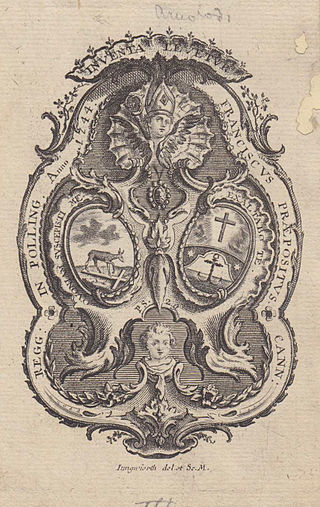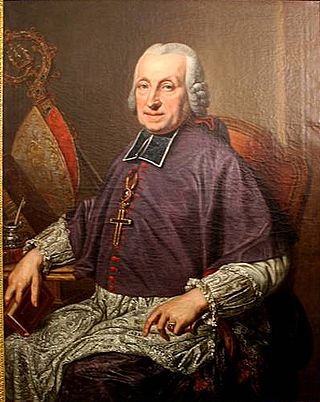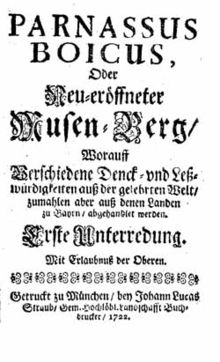
Eusebius Amort was a German Roman Catholic theologian.

The Bavarian Academy of Sciences and Humanities is an independent public institution, located in Munich. It appoints scholars whose research has contributed considerably to the increase of knowledge within their subject. The general goal of the academy is the promotion of interdisciplinary encounters and contacts and the cooperation of representatives of different subjects.

Neue Deutsche Biographie is a biographical reference work. It is the successor to the Allgemeine Deutsche Biographie. The 26 volumes published thus far cover more than 22,500 individuals and families who lived in the German language area.

Tegernsee is a town in the Miesbach district of Bavaria, Germany. It is located on the shore of Lake Tegernsee, which is 747 m (2,451 ft) above sea level. A spa town, it is surrounded by an alpine landscape of Upper Bavaria, and has an economy mainly based on tourism.

The Royal Prussian Academy of Sciences was an academy established in Berlin, Germany on 11 July 1700, four years after the Prussian Academy of Arts, or "Arts Academy," to which "Berlin Academy" may also refer. In the 18th century, it was a French-language institution since French was the language of science and culture during that era.

The Prussian Academy of Arts was a state arts academy first established in Berlin, Brandenburg, in 1694/1696 by prince-elector Frederick III, in personal union Duke Frederick I of Prussia, and later king in Prussia.
Hermann Wagner is a German scientist in the field of microbiology and immunology and past Dean of the Medical Faculty of the Technical University Munich (TUM). His massive number of published works, at over 370, makes him one of Europe's most cited immunologists.
Friedrich Jürgen Baethgen was a German historian born in Greifswald. He specialized in medieval studies and in history of the papacy.

The Bavarian Maximilian Order for Science and Art was first established on 28 November 1853 by King Maximilian II von Bayern. It is awarded to acknowledge and reward excellent and outstanding achievements in the field of science and art. From 1933 onwards the order was no longer awarded, until 1980 when it was reinstated by the then Minister-President of the Free State of Bavaria Franz Josef Strauß. Munich jewellers Hemmerle have been responsible for making the medal since 1905.
Werner Beierwaltes was a German academic best known as a historian of philosophy. His most important areas of specialization were Neoplatonism and German Idealism. He was an Emeritus Professor of Philosophy at the Ludwig Maximilian University of Munich.
Otto Meitinger was a German architect and preservationist. From 1987 to 1995 he was president of the Technical University Munich.

Johann Georg von Lori was a Bavarian high official, lawyer and historian. He was the driving force behind the foundation of the Bavarian Academy of Sciences and Humanities in 1759.

Franz Töpsl was an Augustinian Canon Regular, provost of Polling Abbey, historian and librarian.

Sigmund von Haimhausen was a Bavarian aristocrat, mining operator, head of the Bavarian Mint and Mines commission, porcelain manufacturer and first president of the Bavarian Academy of Sciences.

The Historische Lexikon Bayerns or Historical Lexicon of Bavaria is a specialist, historical lexicon about the History of Bavaria, which has been published as a genuine online publication. It is the first specialised lexicon on the history of the Free State of Bavaria and its various regions.

Count Maximilian Ulrich von Kaunitz-Rietberg was an Austrian diplomat and politician who served as governor of Moravia from 1720 until his death. He was the father of the powerful state chancellor of Maria Theresa, Holy Roman Empress and Queen Regnant of Bohemia and Hungary, Wenzel Anton, Prince of Kaunitz-Rietberg.

Georg Aumann, was a German mathematician. He was known for his work in general topology and regulated functions. During World War II, he worked as part of a group of five mathematicians, recruited by Wilhelm Fenner, and which included Ernst Witt, Alexander Aigner, Oswald Teichmueller and Johann Friedrich Schultze, and led by Wolfgang Franz, to form the backbone of the new mathematical research department in the late 1930s, which would eventually be called: Section IVc of Cipher Department of the High Command of the Wehrmacht. He also worked as a cryptanalyst, on the initial breaking of the most difficult cyphers. He also researched and developed cryptography theory.

Stephan Alexander Würdtwein was a German theologian, auxiliary bishop of Worms, and historian, particularly of the Catholic Church and of the history of the city of Mainz.
Gerrit Walther is a German historian.

The House of Poschinger is an ancient Bavarian noble family. It traces its origins back to 1140. The family received the rank of Knights of the Holy Roman Empire. The Frauenau branch rose to the rank of Barons (Freiherr) in the Kingdom of Bavaria and held a hereditary seat in the House of Councillors.















